SUSTAINABILITY REPORT 2015
kbiQcx
kbiQcx
Create successful ePaper yourself
Turn your PDF publications into a flip-book with our unique Google optimized e-Paper software.
Caring for the health and welfare of stock is the primary<br />
responsibility of any farmer. The investment in our fish health<br />
department, systems, equipment and training reflects the utmost<br />
level of importance Tassal places on the health and welfare of our<br />
Salmon.<br />
Salmon Health<br />
and Welfare<br />
Good fish health and welfare outcomes do not occur in<br />
isolation which is why our approach to managing fish health<br />
focuses on optimal marine operations, optimal environmental<br />
management and optimal husbandry practices.<br />
All of our broodstock are kept in freshwater flow through tank<br />
systems in the highlands of Tasmania and our young fish,<br />
reared up to smoltification, are either in these same locations<br />
or at our freshwater recirculation hatchery at Ranelagh in the<br />
Huon Valley. Once transported to our marine sites all our fish<br />
are housed in polar circle sea cages.<br />
Breeding and Genetics<br />
Performance improvements from the Selective Breeding<br />
Program (SBP) continued to flow into commercial production<br />
throughout 2014-<strong>2015</strong>. The SBP continues to focus on<br />
reducing the susceptibility of our Salmon to Amoebic Gill<br />
Disease (AGD), thereby improving fish welfare and reducing<br />
freshwater use. In FY<strong>2015</strong> Tassal fostered international<br />
collaborations and developed research in the area of genomics<br />
to ensure that the rate of improvement in AGD resistance<br />
continues into the future.<br />
Tassal does not farm genetically modified (GMO) Salmon.<br />
Zero Harm for Fish<br />
Tassal’s voluntary Zero Harm for Fish program, implemented<br />
in January <strong>2015</strong>, audits the functioning of the fish health<br />
management plan (operations and resourcing) as well as other<br />
husbandry factors that can cause disease. The Zero Harm<br />
scorecard drives a culture of continual improvement that aims<br />
for a target of 91% survival. This program is a comprehensive<br />
roadmap to better fish health and welfare built around<br />
RSPCA principles. It is also an important platform to drive<br />
standardisation of operations and the sharing of best practice<br />
husbandry and systems.<br />
Scorecards are used to quantify each region’s performance in<br />
the following areas:<br />
• Fish husbandry/welfare<br />
• Fish health<br />
• Fish quality<br />
• Management systems, and<br />
• Emergency preparedness.<br />
Each of the scorecard segments is weighted according to how<br />
important the standards are for fish health and welfare. Many<br />
of the standards are aimed at promoting best practice culture<br />
58 Tassal Sustainability Report <strong>2015</strong>


